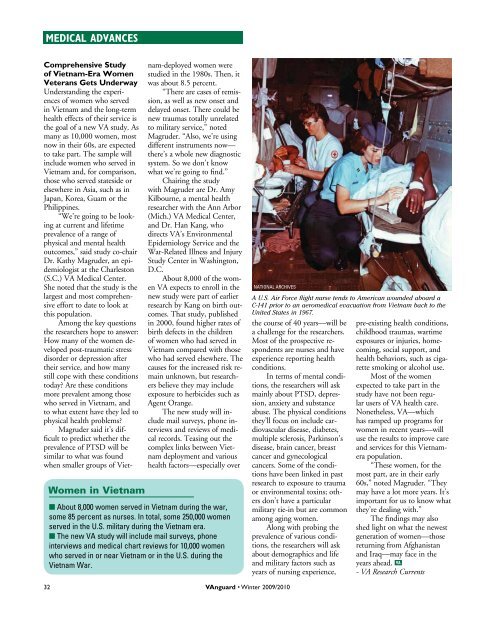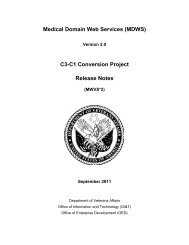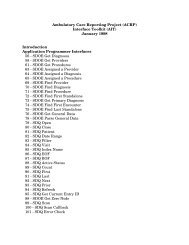Wounded ounded Warrior arrior Car ee - US Department of ...
Wounded ounded Warrior arrior Car ee - US Department of ...
Wounded ounded Warrior arrior Car ee - US Department of ...
Create successful ePaper yourself
Turn your PDF publications into a flip-book with our unique Google optimized e-Paper software.
MEDICAL ADVANCES<br />
Comprehensive Study<br />
<strong>of</strong> Vietnam-Era Women<br />
Veterans Gets Underway<br />
Understanding the experiences<br />
<strong>of</strong> women who served<br />
in Vietnam and the long-term<br />
health effects <strong>of</strong> their service is<br />
the goal <strong>of</strong> a new VA study. As<br />
many as 10,000 women, most<br />
now in their 60s, are expected<br />
to take part. The sample will<br />
include women who served in<br />
Vietnam and, for comparison,<br />
those who served stateside or<br />
elsewhere in Asia, such as in<br />
Japan, Korea, Guam or the<br />
Philippines.<br />
“We’re going to be looking<br />
at current and lifetime<br />
prevalence <strong>of</strong> a range <strong>of</strong><br />
physical and mental health<br />
outcomes,” said study co-chair<br />
Dr. Kathy Magruder, an epidemiologist<br />
at the Charleston<br />
(S.C.) VA Medical Center.<br />
She noted that the study is the<br />
largest and most comprehensive<br />
effort to date to look at<br />
this population.<br />
Among the key questions<br />
the researchers hope to answer:<br />
How many <strong>of</strong> the women developed<br />
post-traumatic stress<br />
disorder or depression after<br />
their service, and how many<br />
still cope with these conditions<br />
today? Are these conditions<br />
more prevalent among those<br />
who served in Vietnam, and<br />
to what extent have they led to<br />
physical health problems?<br />
Magruder said it’s diffcult<br />
to predict whether the<br />
prevalence <strong>of</strong> PTSD will be<br />
similar to what was found<br />
when smaller groups <strong>of</strong> Viet<br />
32<br />
Women in Vietnam<br />
nam-deployed women were<br />
studied in the 1980s. Then, it<br />
was about 8.5 percent.<br />
“There are cases <strong>of</strong> remission,<br />
as well as new onset and<br />
delayed onset. There could be<br />
new traumas totally unrelated<br />
to military service,” noted<br />
Magruder. “Also, we’re using<br />
different instruments now—<br />
there’s a whole new diagnostic<br />
system. So we don’t know<br />
what we’re going to fnd.”<br />
Chairing the study<br />
with Magruder are Dr. Amy<br />
Kilbourne, a mental health<br />
researcher with the Ann Arbor<br />
(Mich.) VA Medical Center,<br />
and Dr. Han Kang, who<br />
directs VA’s Environmental<br />
Epidemiology Service and the<br />
War-Related Illness and Injury<br />
Study Center in Washington,<br />
D.C.<br />
About 8,000 <strong>of</strong> the women<br />
VA expects to enroll in the<br />
new study were part <strong>of</strong> earlier<br />
research by Kang on birth outcomes.<br />
That study, published<br />
in 2000, found higher rates <strong>of</strong><br />
birth defects in the children<br />
<strong>of</strong> women who had served in<br />
Vietnam compared with those<br />
who had served elsewhere. The<br />
causes for the increased risk remain<br />
unknown, but researchers<br />
believe they may include<br />
exposure to herbicides such as<br />
Agent Orange.<br />
The new study will include<br />
mail surveys, phone interviews<br />
and reviews <strong>of</strong> medical<br />
records. Teasing out the<br />
complex links betw<strong>ee</strong>n Vietnam<br />
deployment and various<br />
health factors—especially over<br />
n about 8,000 women served in Vietnam during the war,<br />
some 85 percent as nurses. in total, some 250,000 women<br />
served in the u.s. military during the Vietnam era.<br />
n the new Va study will include mail surveys, phone<br />
interviews and medical chart reviews for 10,000 women<br />
who served in or near Vietnam or in the u.s. during the<br />
Vietnam War.<br />
NatioNal arcHiVes<br />
VAnguard • Winter 2009/2010<br />
A U.S. Air Force fight nurse tends to American w<strong>ounded</strong> aboard a<br />
C-141 prior to an aeromedical evacuation from Vietnam back to the<br />
United States in 1967.<br />
the course <strong>of</strong> 40 years—will be<br />
a challenge for the researchers.<br />
Most <strong>of</strong> the prospective respondents<br />
are nurses and have<br />
experience reporting health<br />
conditions.<br />
In terms <strong>of</strong> mental conditions,<br />
the researchers will ask<br />
mainly about PTSD, depression,<br />
anxiety and substance<br />
abuse. The physical conditions<br />
they’ll focus on include cardiovascular<br />
disease, diabetes,<br />
multiple sclerosis, Parkinson’s<br />
disease, brain cancer, breast<br />
cancer and gynecological<br />
cancers. Some <strong>of</strong> the conditions<br />
have b<strong>ee</strong>n linked in past<br />
research to exposure to trauma<br />
or environmental toxins; others<br />
don’t have a particular<br />
military tie-in but are common<br />
among aging women.<br />
Along with probing the<br />
prevalence <strong>of</strong> various conditions,<br />
the researchers will ask<br />
about demographics and life<br />
and military factors such as<br />
years <strong>of</strong> nursing experience,<br />
pre-existing health conditions,<br />
childhood traumas, wartime<br />
exposures or injuries, homecoming,<br />
social support, and<br />
health behaviors, such as cigarette<br />
smoking or alcohol use.<br />
Most <strong>of</strong> the women<br />
expected to take part in the<br />
study have not b<strong>ee</strong>n regular<br />
users <strong>of</strong> VA health care.<br />
Nonetheless, VA—which<br />
has ramped up programs for<br />
women in recent years—will<br />
use the results to improve care<br />
and services for this Vietnamera<br />
population.<br />
“These women, for the<br />
most part, are in their early<br />
60s,” noted Magruder. “They<br />
may have a lot more years. It’s<br />
important for us to know what<br />
they’re dealing with.”<br />
The fndings may also<br />
shed light on what the newest<br />
generation <strong>of</strong> women—those<br />
returning from Afghanistan<br />
and Iraq—may face in the<br />
years ahead.<br />
- VA Research Currents
















